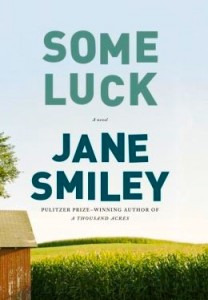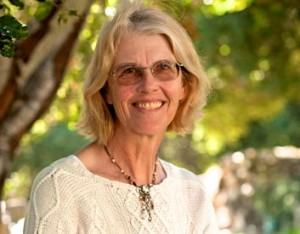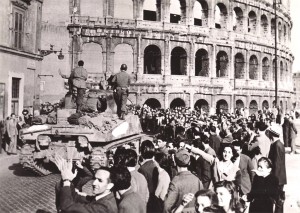NOTE: Jane Smiley was WINNER of the Pulitzer Prize for Fiction in 1992 for A Thousand Acres, and WINNER of the National Book Critics Circle Award for the same novel. She is LONGLISTED for the National Book Award in 2014 for Some Luck.
“The farm was the source of all good things, and what you couldn’t grow or make there, you didn’t need. People in town had too much time on their hands, so they built themselves stores and picture shows and even parks, just to be doing something. But really they weren’t doing anything. Just using up stuff.”—Walter Langdon, in 1926.
 Setting her novel in the farmlands of Iowa, as she did with A Thousand Acres, author Jane Smiley once again homes in on a proud farm family as it faces crises connected with its land. This novel, however, has a broader, less intensely climactic sweep than A Thousand Acres, in which the action parallels that of Shakespeare’s King Lear. Some Luck is quieter and more contemplative, the first of a trilogy which will eventually trace three generations of the Langdon family from 1920 to 2020, as it becomes a microcosm for one hundred years of United States history. Smiley’s characters, beautifully realized through her trademark use of perfect small details to illuminate bigger aspects of personality, illustrate the many different talents, and ultimately goals, of a family whose members are firmly rooted in the land, which is their only real asset. Some members will eventually choose to leave the farm, while others choose to stay. Smiley limits each chapter to one calendar year beginning in 1920 – the births and deaths, the hopes and dreams, the rhythms of nature and the yearly rituals it inspires, the uncertainties of daily life and the accidents of fate, the roles which each character chooses to accept or reject within the family, and the unpredictable, often dramatic effects of national events on people who have no control over them. The novel ends in 1953 with the focus on new family members who will face another set of topical issues in the next novel.
Setting her novel in the farmlands of Iowa, as she did with A Thousand Acres, author Jane Smiley once again homes in on a proud farm family as it faces crises connected with its land. This novel, however, has a broader, less intensely climactic sweep than A Thousand Acres, in which the action parallels that of Shakespeare’s King Lear. Some Luck is quieter and more contemplative, the first of a trilogy which will eventually trace three generations of the Langdon family from 1920 to 2020, as it becomes a microcosm for one hundred years of United States history. Smiley’s characters, beautifully realized through her trademark use of perfect small details to illuminate bigger aspects of personality, illustrate the many different talents, and ultimately goals, of a family whose members are firmly rooted in the land, which is their only real asset. Some members will eventually choose to leave the farm, while others choose to stay. Smiley limits each chapter to one calendar year beginning in 1920 – the births and deaths, the hopes and dreams, the rhythms of nature and the yearly rituals it inspires, the uncertainties of daily life and the accidents of fate, the roles which each character chooses to accept or reject within the family, and the unpredictable, often dramatic effects of national events on people who have no control over them. The novel ends in 1953 with the focus on new family members who will face another set of topical issues in the next novel.
Born on New Year’s Day in 1920 to twenty-five-year-old Walter Langdon and his twenty-year-old wife Rosanna, precocious baby Frank Langdon surprises his family from his earliest days, talking early, crawling early, and alertly observing life around him. His cleverly developed, infant point of view, as he attends his first birthday party at his grandparents’ house, reveals his curiosity and his sense of fun as he “pays court” to the women in the family and is roundly celebrated. His aunt Eloise soon moves in with the family to help care for him as his mother has her next child – Joe – totally different in personality, shy, sickly as an infant, less aggressive, and more sensitive. Another baby, Mary Elizabeth, arrives in 1924. Life is busy on the farm, with no electricity and no motorized vehicles, but with a culture in which the farmers help each other bring in their harvests and share information. Before he is even five, Frank is already contributing to the family, leading the horses in and out of the pasture, and feeding the chickens and horses in the winter before school.
The domestic aspects of life on the farm with all its uncertainties, the games the family plays for fun, and lively descriptions of tasks like sheep-shearing alternating with family stories, set up the reader for an unexpected and shocking death which leads Rosanna to attend a religious revival by traveling evangelist Billy Sunday. For her, “Coming again and again…was like having an account at the bank.” She changes in personality, fearful of the future now, dressing more plainly and giving up “vanity” in an effort to avoid future disasters but can do nothing to avoid what is coming – the Great Depression, a well going dry, drought, and terrible weather which reduce the amount of oats and corn available to sell. By 1931, one member of the family has become a communist, Walter has changed political parties, and another baby has arrived. Frank sells pelts of rabbits and an occasional fox for enough money to buy a bike so that he can continue school, and when he leaves the farm for high school, living with a relative, he is known as “the best liar” in a gang of young boys.

REO Flying Cloud, part of a collection of REO pictures by Alden Jewell. Double click to see collection.
History moves forward inexorably, with one family member hanging himself, even as Frank and a friend, by 1939, begin exploring the countryside near their school in the friend’s father’s REO Flying Cloud. Exactly what he is doing remains a question even after he begins working at the school helping a faculty member to find a new way to make gunpowder in the lead-up to World War II. The various Langdon children, including two more babies (bringing to six the number of Langdon babies), keep life on the farm active for Rosanna. Fate intervenes once again with a surprising death from an impacted wisdom tooth, and by 1943, Frank is fighting in North Africa, Sicily, and Italy. Eventually, the action of the novel extends to Washington, DC, as the work of the FBI and the interest in “un-American activities” affects the Langdon family as it has many other families throughout the country. The novel ends suddenly in 1953, the author obviously leaving many doors open for the next novel in the trilogy.
Smiley’s characters are so “ordinary” that they are easy for a reader to identify with, and her focus on the long view of history through this family makes them easy enough to remember and not so complex that the reader is distracted from the themes. The family is large enough to provide many contrasts and different viewpoints as the characters represent the many aspects of life in the twenties, thirties, and forties. Some scenes do seem gratuitous – a visit to Frank’s mother by one of Frank’s former girlfriends, Frank’s own visit to a house of ill repute, and several battle scenes – which provide variety and interest but seem to serve little purpose in the narrative. The many characters, some of them peripheral, make the genealogical chart at the beginning a necessity but complicate the novel unnecessarily.

A continuing symbolic image is that of the osage-orange hedge at the farm. Here someone creates this hedge, covered with thorns, which eventually grows to be almost tree height.
Still, Jane Smiley continues to work her literary magic here, creating the first novel in what seems destined to become an epic saga of American life. For all its apparent simplicity, the novel takes a close view of major themes in American life – one’s identity both within a family and within a time and place, the uncertainties of nature and of fate, the very nature of capitalism and its effect on the small farmers on whom we all depend, and the issues of our own national identity. Smiley leaves the reader wondering where she will go from here during the next thirty years of this intriguing trilogy.
Photos, in order: The author’s photo is from http://www.theguardian.com
The Billy Sunday lithograph by George Bellows appears on http://arthopper.org/ It may be found at the Columbus Museum of Art.
The REO Flying Cloud sedan, shown here as part of a collection of REO pictures by Alden Jewell, is from https://www.flickr.com/ and is posted in accord with the Creative Commons license. Double click to see the full collection, including the REO Speedwagon.
American tanks entering Rome on June 5, 1944, may be found on http://liberationtrilogy.com. Frank Langdon was among the Americans.
The osage-orange hedge becomes a prickly symbol in this novel. Here a woman shows how to create one. http://projetscollectifs.org/
A close-up of the osage-orange tree with its fruit (poisonous to all animals except squirrels) is on http://www.ontarioprofessionals.com/




